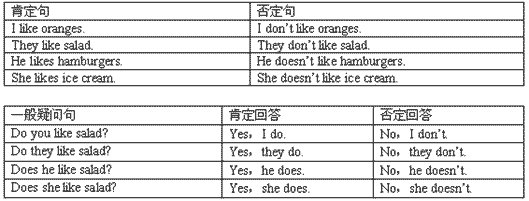根据要求,改写下列句子。 1. I arrived in Beijing before dark yesterday. (改为一般疑问句) 2. Our plane leaves at ten o'clock tonight. (改为否定句)3. Leo and-八年级英语
变y为i,再加es
fly(飞翔)
try(尝试)
flies
tries
特殊变化的词:
be (是) - am,is,are
I am
she/he/it,名词单数都用 is
we,you,they,名词复数都用are
have (有) - have,has
I,we,you,they,名词复数都用have
she/he/it is,名词单数都用 has
助动词,不论单复数、不论什么人称都没有变化,都用 can,may,must,need,ought to 等。
而且,句子中有了助动词,谓语动词就不需要有任何变化了,即用动词原形表示。例:
We have six classes every day. 我们每天上六节课。
I often get up at 6:30. 我经常6:30起床。
Jack likes Chinese food very much.杰克很喜欢中国饮食。
We can see some pictures on the wall. 我们能看到墙上的画。
4.一般现在时常用的时间词语
常用于一般现在时的词语有 sometimes/usually/often/every day(week,year)/ now/always 等。
这些时间词语只是辅助作用,这些词语也可用于其它的时态,所以谓语动词变化才是最关键的。
注意:当表现强烈的感情色彩时,尽管有如 always/never/seldom 等频率副词,但一般在频率副词前加上be动词,后面变为动词的现在分词形式。
例:My father lose his key again. He is always losing his key.

一般现在时中当主语为第三人称单数的时,动词上要改为第三人称单数形式。
考点名称:状语从句
- 状语从句:
指句子用作状语时,起副词作用的句子。它可以修饰谓语、非谓语动词、定语、状语或整个句子。
根据其作用可分为时间、地点、原因、条件、目的、结果、让步、方式和比较等从句。
状语从句一般由连词(从属连词)引导,也可以由词组引起。
从句位于句首或句中时通常用逗号与主句隔开,位于句尾时可以不用逗号隔开。 - 状语从句分类:
1、时间状语从句
常用引导词:
when, as, while, as soon as, while, before, after, since , till, until
特殊引导词:
the minute, the moment, the second, every time, the day,the instant, immediately , directly, no sooner … than, hardly …when, scarcely … when
I didn't realize how special my mother was until I became an adult.
While John was watching TV, his wife was cooking.
The children ran away from the orchard(果园) the moment they saw the guard.
No sooner had I arrived home than it began to rain.
Every time I listen to your advice, I get into trouble.
2、地点状语从句
常用引导词:
where
特殊引导词:
wherever, anywhere, everywhere
Generally, air will be heavily polluted where there are factories.
Wherever you go, you should work hard.
3、原因状语从句
常用引导词:
because, since, as, for
特殊引导词:
seeing that, now that, in that, considering that, given that, considering that, as much as, so much as
My friends dislike me because I'm handsome and successful.
Now that everybody has come, let's begin our conference.
The higher income tax is harmful in that it may discourage people from trying to earn more.
Considering that he is no more than 12 years old, his height of 1.80 m is quite remarkable.
4、目的状语从句
常用引导词:
so that, in order that
特殊引导词:
lest, in case, for fear that,in the hope that, for the purpose that, to the end that
The boss asked the secretary to hurry up with the letters so that he could sign them.
The teacher raised his voice on purpose that the students in the back could hear more clearly.
5、结果状语从句
常用引导词:
so that, so… that, such … that,
特殊引导词:
such that, to the degree that, to the extent that, to such a degree that,
He got up so early that he caught the first bus.
It's such a good chance that we must not miss it.
To such an degree was he excited that he couldn't sleep last night.
6、条件状语从句
常用引导词:
if, unless,
特殊引导词:
as/so long as, only if, providing/provided that, suppose that, in case that, on condition that
We'll start our project if the president agrees.
You will certainly succeed so long as you keep on trying.
Provided that there is no opposition, we shall hold the meeting here.
7、让步状语从句
常用引导词:
though, although, even if, even though
特殊引导词:
as(用在让步状语从句中必须要倒装),while ( 一般用在句首 ),no matter …, in spite of the fact that, while, whatever, whoever, wherever, whenever, however, whichever
Much as I respect him, I can't agree to his proposal.
尽管我很尊敬他, 我却不同意他的建议。
The old man always enjoys swimming even though the weather is rough.
No matter how hard he tried, she could not change her mind.
He won't listen whatever you may say.
8、比较状语从句
常用引导词:
as(同级比较), than(不同程度的比较)
特殊引导词:
the more … the more … ; just as …, so…; A is to B what /as X is to Y; no … more than; not A so much as B
She is as bad-tempered as her mother.
The house is three times as big as ours.
The more you exercise, the healthier you will be.
Food is to men what oil is to machine. 食物之于人,犹如油之于机器。
9、方式状语从句
常用引导词:
as, as if, how
特殊引导词:
the way
When in Rome, do as the Roman do.
She behaved as if she were the boss.
Sometimes we teach our children the way our parents have taught us. 状语从句用法:
时间状语从句
(1) when引导的时间状语从句
①.when引导的时间状语从句,其动词既可以是延续性动作的动词,也可以是瞬间性动作的动词,而且可以表示主句的动作和从句的动作同时发生,或者从句的动作发生在主句的动作之前。如:
when you apply for a job, you must present your credentials.
当你申请工作时,你必须递交你的有关证件。(同时)
when the students heard the teacher’s footsteps, they all atopped talking.
当学生们听到老师的脚步声时,他们都停止了讲话。(从句动作发生在前)
② when还可表示just then(正在那时,突然)的意思,此时其所引导的从句只放在主句之后。如:
we were about to start when it began to rain.
我们正要动身,突然天下起雨来。
The game had hardly/scarcely/barely begun when it started raining.
比赛刚刚开始就下起雨来。
(2) as引导的时间状语从句
as引导的时间状语从句其动词的动作是延续性的,而且侧重表示主句和从句的动作并相发生:
- 最新内容
- 相关内容
- 网友推荐
- 图文推荐
| [家长教育] 孩子为什么会和父母感情疏离? (2019-07-14) |
| [教师分享] 给远方姐姐的一封信 (2018-11-07) |
| [教师分享] 伸缩门 (2018-11-07) |
| [教师分享] 回家乡 (2018-11-07) |
| [教师分享] 是风味也是人间 (2018-11-07) |
| [教师分享] 一句格言的启示 (2018-11-07) |
| [教师分享] 无规矩不成方圆 (2018-11-07) |
| [教师分享] 第十届全国教育名家论坛有感(二) (2018-11-07) |
| [教师分享] 贪玩的小狗 (2018-11-07) |
| [教师分享] 未命名文章 (2018-11-07) |




![—Is this your chair? —_______[ ]A. Yes, it'sB. Yes, it's notC. No, it isD. Yes , it is-七年级英语](http://www.00-edu.com/d/file/ks/4/2/yibanyiwenju/2020-03-01/small1dad3d68a5c6e17eaace414966b1adff1582995860.png)
![—Do you have a bike?—Yes, _____.[ ]A. I don't B. I am C. I do D. you do-七年级英语](http://www.00-edu.com/d/file/ks/4/2/yibanyiwenju/2020-03-01/smallfaa7a6b3eddd24507e7c9593b83e49a41582997203.png)
